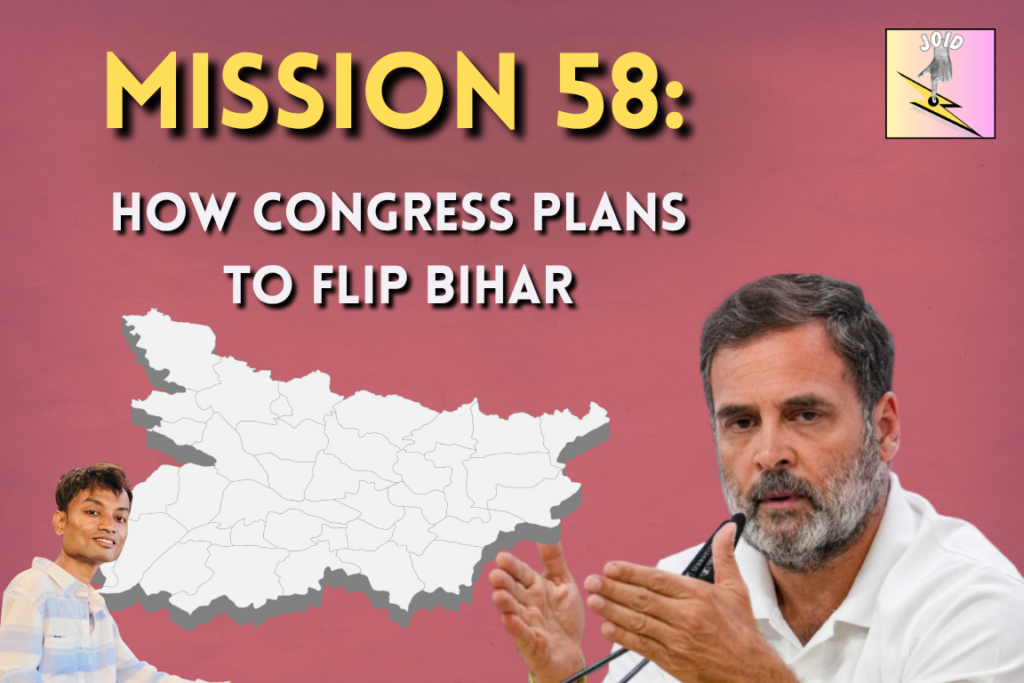
By Mayur Gavture | Political Consultant & Legislative Associate
As Bihar heads into the 2025 Assembly elections, the Indian National Congress stands at a critical political juncture. In the 2020 elections, despite contesting 70 seats under the Mahagathbandhan banner alongside the Rashtriya Janata Dal (RJD) and Left parties, Congress managed to win only 19 constituencies. The verdict was clear: a scattered, unfocused approach was no longer sustainable. In response, Congress has now charted a sharp, data-driven path forward narrowing its focus to 58 strategically chosen constituencies across four regions of Bihar. This new blueprint, built on three cycles of electoral data, caste demography, vote-share trends, and ground-level sentiment analysis, is not only a tactical shift but a political necessity. If implemented with discipline and regional sensitivity, the party can realistically win 28 to 34 of these 58 seats, playing a decisive role in government formation and repositioning itself as a serious political force in the Hindi heartland.
The first and most promising zone is the Seemanchal and Koshi belt, comprising 21 constituencies spread across the Muslim-Yadav dominated districts of Purnia, Araria, Katihar, Kishanganj, Madhepura, and Supaul. In 2020, Congress secured 9 of these seats with an average vote share of 39.4%. However, internal vote leakage due to the AIMIM’s rise and poor booth-level organization capped their success. In 2025, with AIMIM weakened and Mahagathbandhan unity intact, Congress is projected to achieve a vote share between 52–58% in this region. Key seats like Araria, Amour, and Kasba are expected to deliver margins upward of 50,000 votes each. However, turning potential into victory will require more than just arithmetic. Congress must raise turnout among Muslims and Dalits from 56% to at least 65% and improve booth-level coverage from a dismal 30% in 2020 to over 90%. Mobilization of Pasmanda groups, engagement with madarsa students, and hyper-local WhatsApp-based micro-campaigning can make the difference between a lead and a landslide.
The second key region is Champaran and Tirhut, which includes East and West Champaran, Sheohar, Sitamarhi, and Muzaffarpur districts. Traditionally a BJP stronghold, this region has been challenging for Congress, which won only two seats here in 2020, with a vote share of around 32%. Yet, the ground dynamics have shifted. The post-COVID wave of return migration, agrarian distress, and rising unemployment has unsettled the BJP’s dominance. Constituencies like Bettiah, Valmiki Nagar, Chanpatia, and Harsidhi (SC) are seeing rising sympathy for the Grand Alliance, with projected vote shares of 45–50%. Congress’s challenge here lies in tapping into upper-caste discontent and Savarna youth anger, especially around the Agniveer scheme and crumbling public sector recruitment. Targeted issue-based campaigns, emphasis on caste-census rights, and alliances with rural youth organizations can potentially deliver 4–6 wins for Congress in this critical belt.
In Magadh and South Bihar, encompassing Gaya, Aurangabad, Nawada, Jamui, Jehanabad, and Arwal, Congress has historically had an emotional connect, particularly among Dalit and Mahadalit communities. In 2020, the party held three seats here with a vote share of 35.1%. Now, with RJD’s caste-census campaign and tribal rights discourse strengthening on the ground, Congress is poised to ride that wave. With projected vote shares of 48–52%, constituencies like Jehanabad, Tikari, Makhdumpur (SC), and Paliganj have become fertile ground for Congress gains. Winning 5–6 seats in this belt would not only consolidate the alliance’s foothold but also reinforce Congress’s image as a grassroots social justice party. The strategy here must center around land rights movements, Scheduled Caste education grievances, tribal self-governance demands, and women’s SHG networks.
The fourth and final region is the Central Bihar and Urban-Rural Edge, comprising 12 constituencies in districts like Bhagalpur, Banka, Samastipur, Buxar, Sheikhpura, and Lakhisarai. In 2020, Congress won five of these seats, averaging a vote share of 36.9%. These are semi-urban, mixed-class constituencies with a blend of aspirational youth and rural women voters ideal for issue-specific campaigning. The party’s projected vote share here is 48–55%, with strong potential wins in Banka, Dhoraiya, Barbigha, and Warisnagar. To convert this promise into power, Congress must run robust campaigns focused on public distribution system (PDS) corruption, women’s health, education, and digital unemployment. The real challenge here is narrative-building: Congress must emerge not just as an old brand but as a future-facing, service-delivering entity.
Altogether, these 58 seats represent not just a strategic subset of Bihar’s 243 Assembly constituencies, but a microcosm of India’s socio-political battle lines between caste justice and authoritarian control, decentralization and centralization, rural aspiration and urban neglect. Winning 28–34 of these seats would position Congress as an indispensable pillar of the Grand Alliance, especially as RJD focuses on consolidating its traditional OBC vote bank and the Left expands marginally in labor pockets. More than the numbers, however, the “Mission 58” approach is symbolic of Congress’s attempt to become leaner, sharper, and more accountable replacing old-school broad-spectrum campaigning with precision-targeted, data-informed, regionally attuned political warfare.
If Congress can build strong booth committees, field winnable local candidates, align with sub-caste dynamics, and maintain narrative control across these 58 seats, it will not only help deliver Mahagathbandhan government in Bihar it will reignite its journey of national political recovery. In this sense, Bihar 2025 is more than a state election for Congress. It is a chance to flip the script, rewrite its relevance, and reclaim its voice in the heart of India’s democracy.
Our other articles : Bengal Bellwether – 2 | Bengal Bellwether – 1 | India United – India’s message is loud & clear on terrorism a diplomatic strike on terror| The Indian Stock Market is bleeding | SUPER NARI – 25 | Caste and the Ballot in Bihar | The suicidal mission of Pakistan’s so called ‘Establishment’ | Who is Responsible for Bihar’s Migration Crisis? | Why Congress must go solo in Bihar | Jai Bhim | Old is Gold , Resurrection of ‘Dynasty Politics’ | China Faces 125% Tariff by USA: A Strategic Opportunity for India | When the Accuser Becomes the Accused
Books that enriches – India after Gandhi by Ramchandra Guha | Contesting democratic deficit by Salman Khurshid | The election that surprised India By Rajdeep Sardesai

Mayur Gavture is a Political Strategy Consultant and currently working as the legislative & Political Associate at the Office of Hon. Member of Parliament Shri Namdev Kirsan. He also has interests in Election Campaign , Legislative Policy – Advocacy & Governance Advisor.
